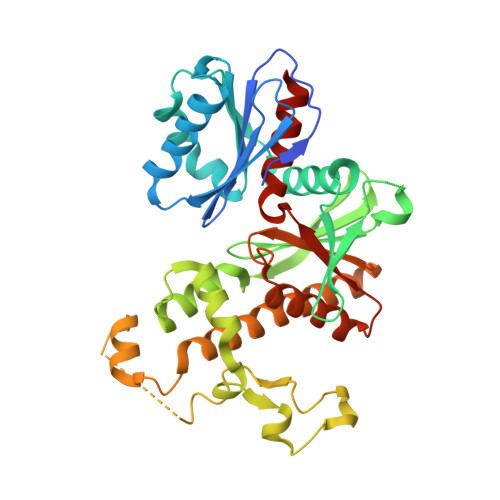High-resolution crystal structure and chemical screening reveal pantothenate kinase as a new target for antifungal development.
Gihaz, S., Gareiss, P., Choi, J.Y., Renard, I., Pal, A.C., Surovsteva, Y., Chiu, J.E., Thekkiniath, J., Plummer, M., Hungerford, W., Montgomery, M.L., Hosford, A., Adams, E.M., Lightfoot, J.D., Fox 3rd, D., Ojo, K.K., Staker, B.L., Fuller, K., Ben Mamoun, C.(2022) Structure 30: 1494
- PubMed: 36167065
- DOI: https://doi.org/10.1016/j.str.2022.09.001
- Primary Citation of Related Structures:
7T1G, 7T1H, 7T1I - PubMed Abstract:
Fungal infections are the leading cause of mortality by eukaryotic pathogens, with an estimated 150 million severe life-threatening cases and 1.7 million deaths reported annually. The rapid emergence of multidrug-resistant fungal isolates highlights the urgent need for new drugs with new mechanisms of action. In fungi, pantothenate phosphorylation, catalyzed by PanK enzyme, is the first step in the utilization of pantothenic acid and coenzyme A biosynthesis. In all fungi sequenced so far, this enzyme is encoded by a single PanK gene. Here, we report the crystal structure of a fungal PanK alone as well as with high-affinity inhibitors from a single chemotype identified through a high-throughput chemical screen. Structural, biochemical, and functional analyses revealed mechanisms governing substrate and ligand binding, dimerization, and catalysis and helped identify new compounds that inhibit the growth of several Candida species. The data validate PanK as a promising target for antifungal drug development.
Organizational Affiliation:
Section of Infectious Diseases, Department of Internal Medicine, Yale University School of Medicine, New Haven, CT 06520, USA.















